Salesforce bulk process wizard for query, insert, update, delete, or hard delete actions in Jitterbit Design Studio
Introduction
This page describes how to create a Salesforce Bulk Process Query, Insert, Update, Delete, or Hard Delete action using the Salesforce Bulk Process Wizard in Jitterbit Design Studio.
- A Salesforce Bulk Query action queries a large number of records from a Salesforce endpoint.
- A Salesforce Bulk Insert action inserts new data in a Salesforce endpoint.
- A Salesforce Bulk Update action updates existing data in a Salesforce endpoint.
- A Salesforce Bulk Delete or Bulk Hard Delete action deletes a large number of existing records in a Salesforce endpoint.
Note
The difference between a Delete and a Hard Delete is that with a Delete, the deleted records are stored in the Salesforce Recycle Bin. With a Hard Delete, records become immediately eligible for deletion. The Salesforce Recycle Bin lets you view and restore recently deleted records for 15 days before they are permanently deleted. There is a limit on the size of the Salesforce Recycle Bin; once exceeded, records can automatically become eligible for deletion. Consult the Salesforce documentation for details.
Query, Insert, Update, Delete, or Hard Delete Bulk Process actions are slightly different than the process for the Bulk process upsert action. Unlike the Bulk Process Upsert action, Query, Insert, Update, Delete, and Hard Delete Bulk Process actions do not require an external ID field and do not include this step.
Before moving through the following steps, see Salesforce bulk process wizard for instructions on starting the Salesforce Bulk Process Wizard.
Select the Salesforce object
On the Object screen, select the Salesforce object that the operation will use.
Note
You can simplify your view by typing the first few letters of an object's name in the Filter text entry box or click the Objects to Show dropdown menu and select from either Standard Common Objects, All Custom Objects, or All Objects.
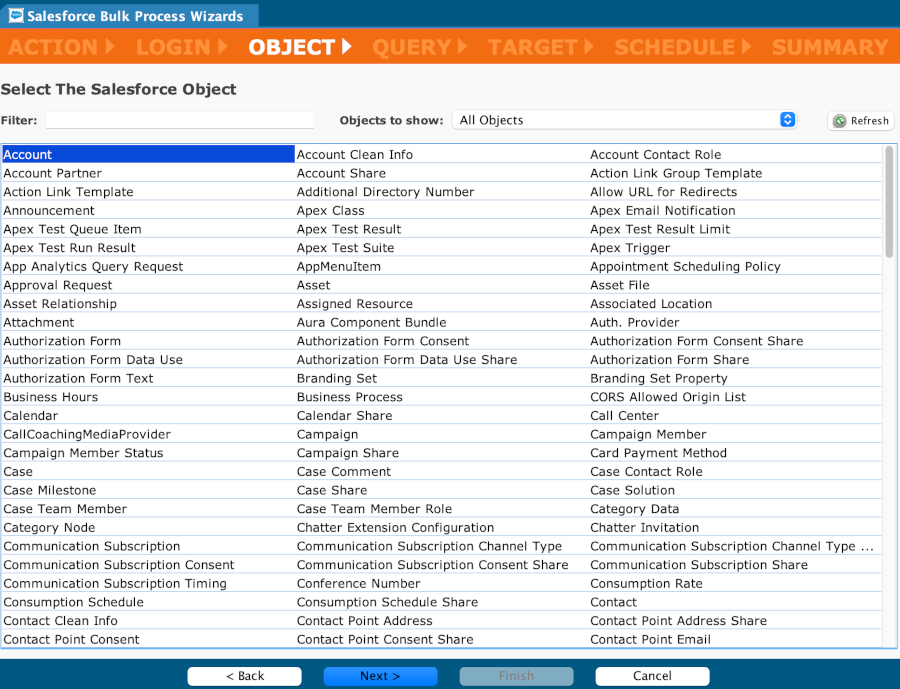
Click Next to move to Define the source.
Define the source
Select where your source data comes from
The source is the location of the data to be used by the operation. For the Salesforce Bulk Process Wizard, the source needs to be a flat file source with a header. Databases are not supported. For the File source select Local File, FTP Site, File Share, or Temporary Storage.
Since your source will need to be a flat file for the Salesforce Bulk Process Wizard, you can optionally add row and field validation. If you prefer, you can instead add a source later in your development of the project. For details on the different sources, see the documentation on Sources.
Select one of:
- An existing source Type from the dropdown menu (one of Local File, FTP Site, File Share, Temporary Storage, or HTTP).
- Select Create New to create a new source of the currently selected type.
Note
The screenshots shown may vary slightly from what is displayed when you use the wizard, as they are based on the Insert Bulk Process Wizard. The steps for configuring a source are the same for all Salesforce Bulk Process Wizards.
Create a new source
To create a new source, select the New Source option from the dropdown menu:
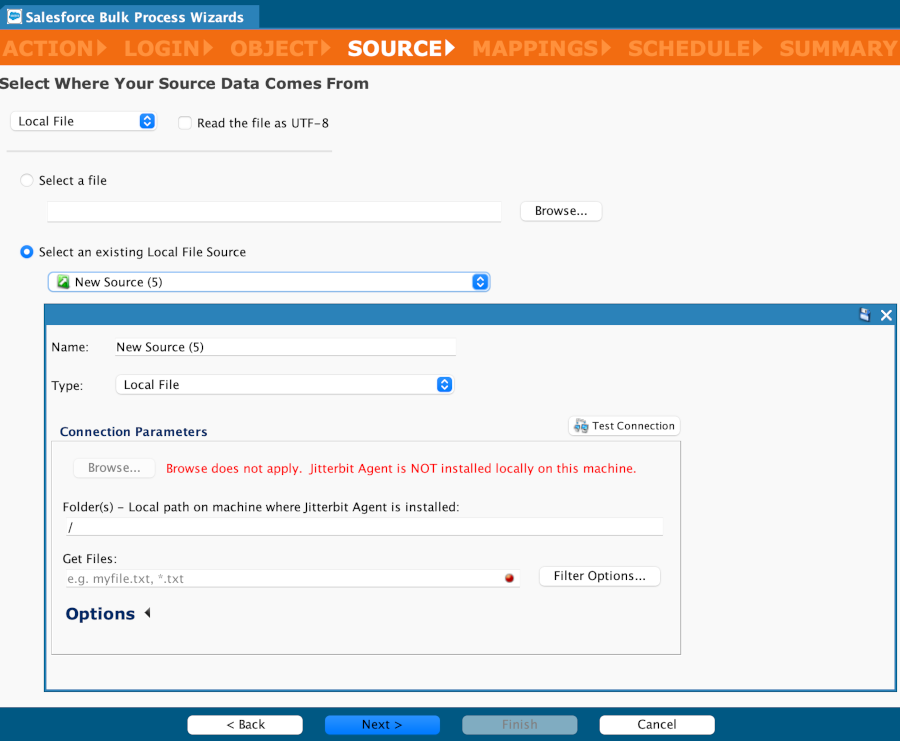
Note
he type of source selected will determine the Connection Parameters to enter. See the documentation on Sources for details.
File sources
For file sources (Local File, FTP Site, File Share, or Temporary Storage), select or create a source and then select or create a file format to use with that source.
Local file
Note
If you are creating a local file source for the first time, you must first enable local file locations in each Jitterbit private agent configuration. (A Local File can be used only with private agents.)
If you select a Local File as a source, click Browse to select a file. Alternatively, if you'd like to use a local file that has been previously used with Jitterbit Design Studio, click Select an Existing Local File Source and use the dropdown menu to select a previously used file.
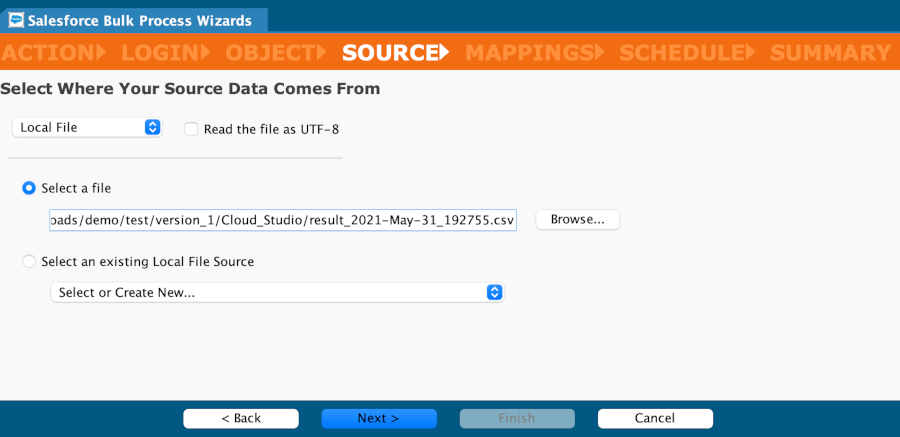
Confirm the selected file after reviewing the first ten lines of the file:
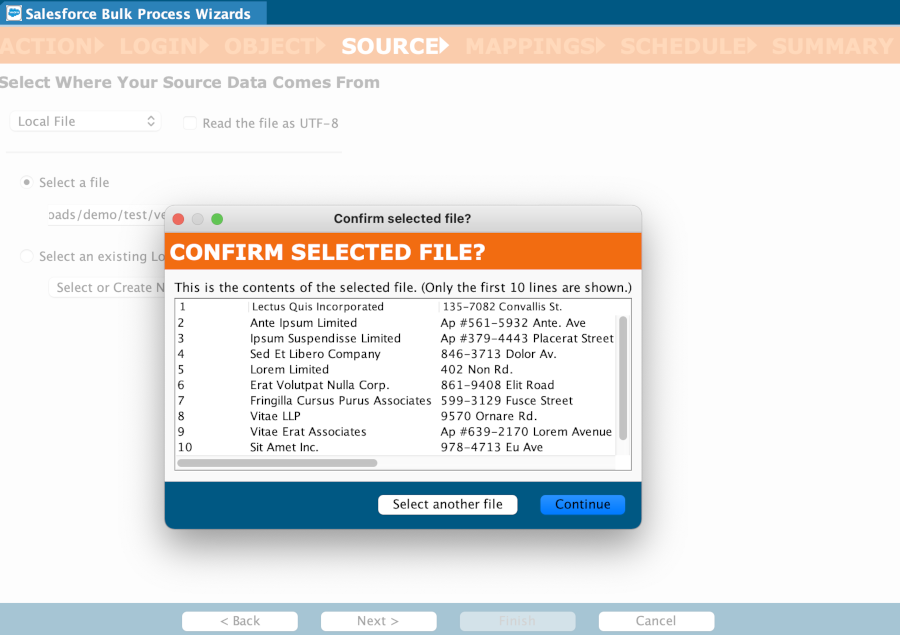
Click Continue to move to the Mappings screen.
FTP site, File Share, or Temporary Storage
If you'd like to use an existing FTP Site as a source, use the Type dropdown menu to select your FTP Site. Otherwise, select Create New in the dropdown menu and populate the Connection Parameters.
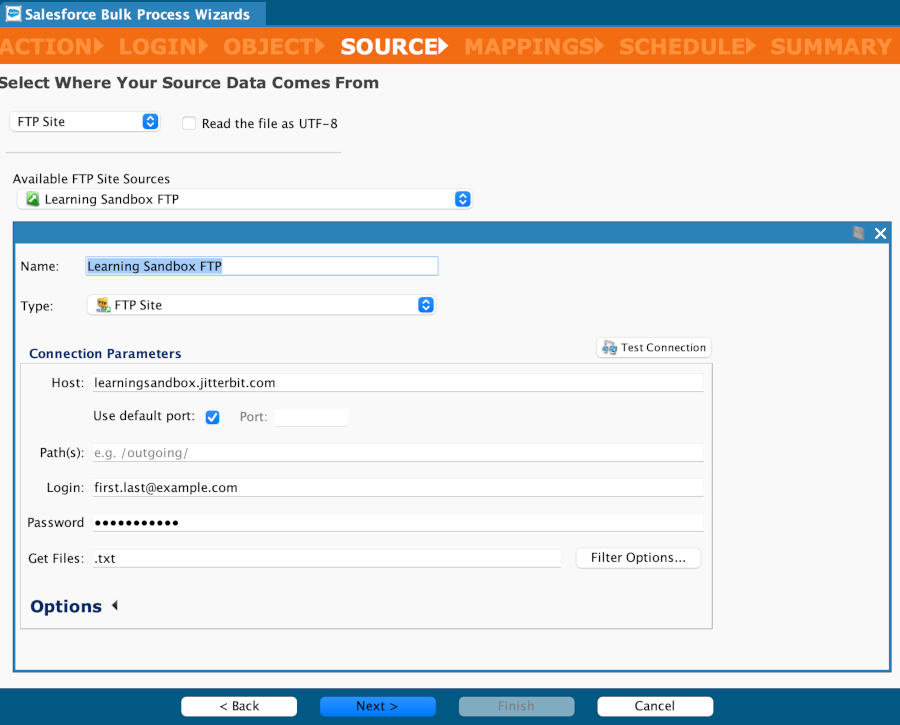
Select sample file
Browse your computer and select a sample file that contains the same format as the file you'd like to send to Salesforce. Design Studio will use this information on the Mappings screen.
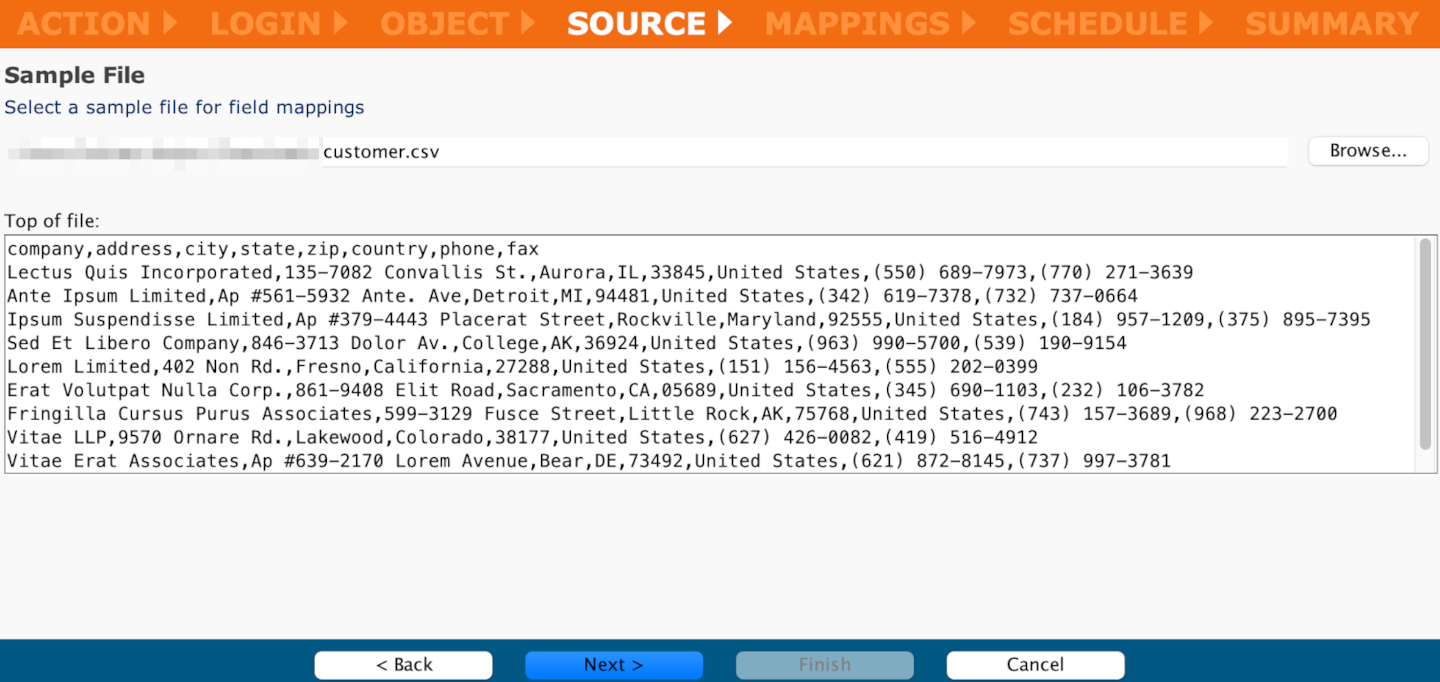
Click Next to move to the Mappings screen.
Transformation mapping
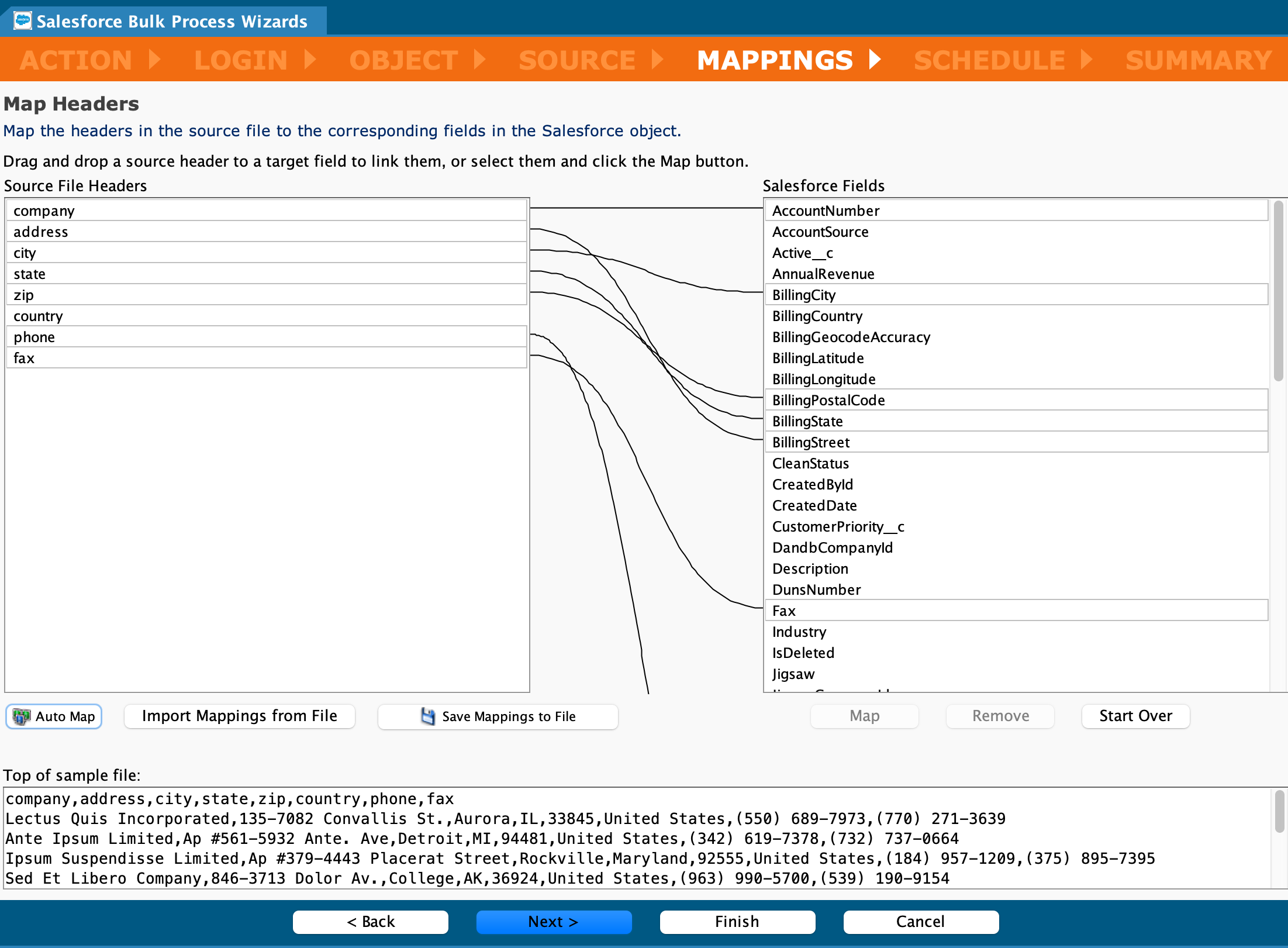
Map headers from the source file to the corresponding Salesforce fields. Aside from the headers, Bulk Process does not involve any other mappings.
You can map:
-
By dragging and dropping a Source File Header to a Salesforce Field.
-
By selecting Source and Salesforce fields together and then clicking the Map button.
-
The Auto Map button maps based on matching names between the Source File Headers and the Salesforce Fields.
-
The Import Mappings from File button imports a previously saved set of mapping from a file.
-
The Save Mappings to File button saves all of the mappings to a local file.
-
The Map button maps between selected source and target fields.
-
The Remove button removes a selected mapping.
-
The Start Over button deletes all of the mappings and starts over.
-
When finished, click Next to move to Create a schedule and set options.
Create a schedule and select options
Creating or setting a schedule is optional and can be done at a later time. For more details on scheduling, see Schedules. You can edit an existing schedule by opening it in the Schedules category of the project items panel and making any desired adjustments. You can use this wizard screen to either add a schedule to an unscheduled operation or open the operation under the project items panel and make the appropriate adjustments.
- Set the Occurrence, Daily Frequency (hours or minutes), and Duration of the operation.
- When setting Duration, be aware that Starting at and Ending at dates in a schedule are inclusive.
- To display these options, open the disclosure triangles beside Occurrence, Daily Frequency, and Duration.
- When finished, click Next to move to Summary screen.
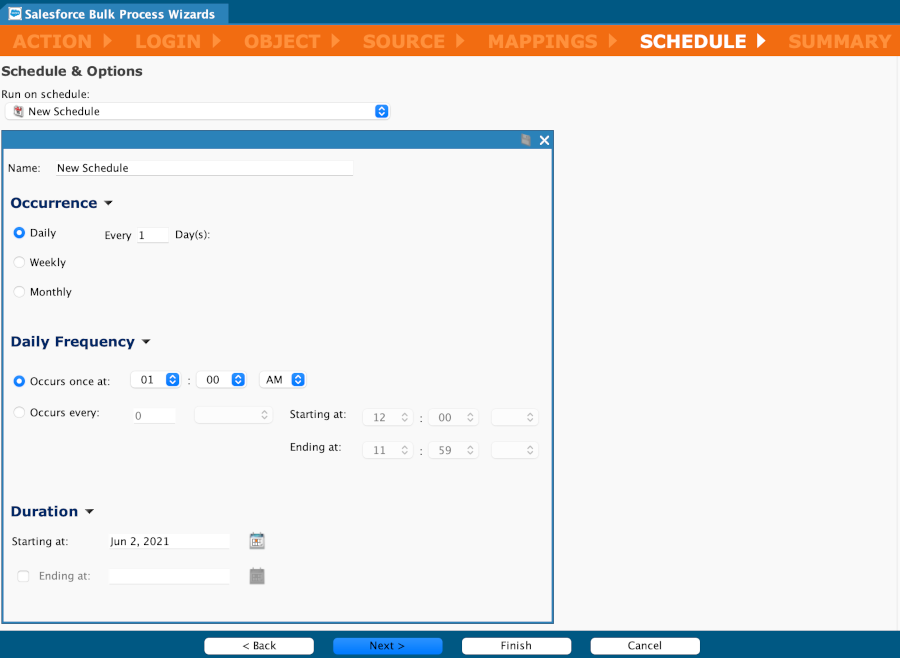
Summary screen
On the Summary screen, you can edit the name given to the wizard:
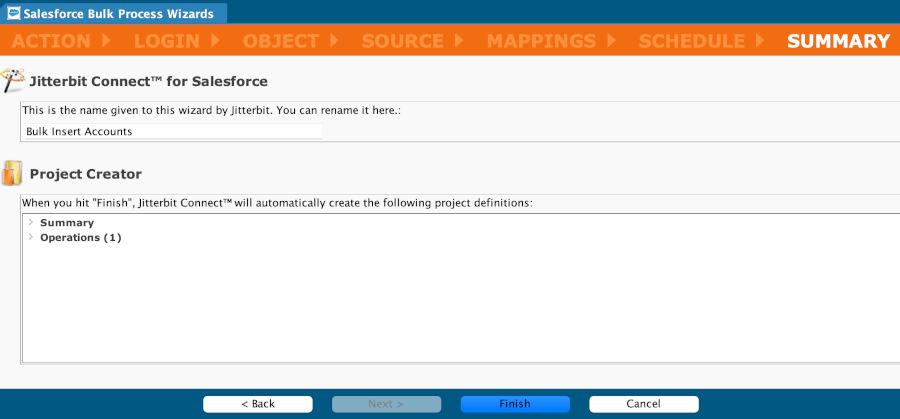
Click Finish to complete the wizard.
Completed Salesforce bulk process
Once completed, you will be taken to the Summary screen for the new Salesforce Bulk Process. You can return to this summary page by finding its operation name under Jitterbit Connect in the project item panel.
- You can modify any of the design items in your project such as Salesforce Login, Mappings, Read Data From, Operation, and Run on Schedule by clicking the adjacent Edit.
- The Run Bulk..., Result History, and Delete button functions are described below in Deploy the project and run the operation (The actual labels and available buttons will vary depending on the particular Bulk Process wizard used. This example shows the Bulk Insert wizard).
- Advanced Options include operation options such as chunking and field truncation. They are covered below in Advanced options.
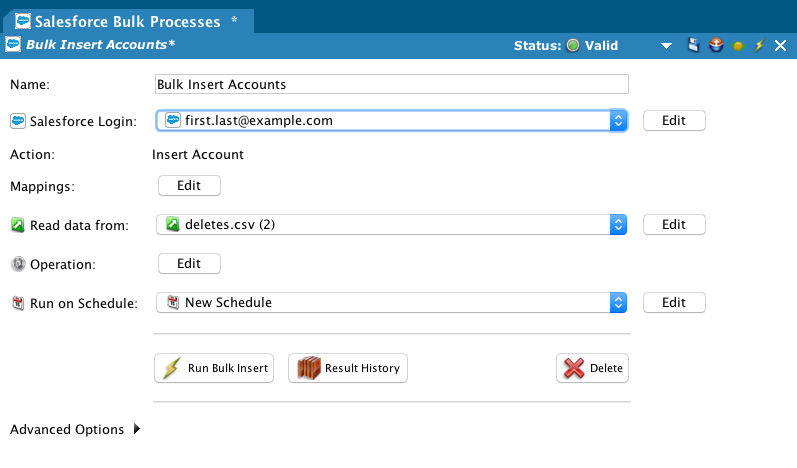
Advanced options
The following advanced options are available for a Salesforce Bulk Process.
For a Query action:

For an Insert or Update action:
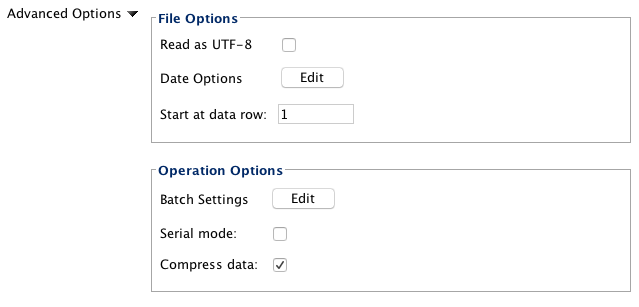
For a Delete or Hard Delete action (the date options are disabled):
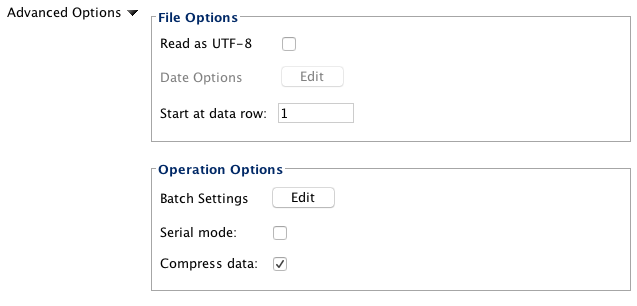
File options
- Read as UTF-8: Select to read the source file as UTF-8 character encoding.
- Write as UTF-8: Select to write the target file as UTF-8 character encoding.
- Date Options: Displays a dialog to set the date options for the source. See the Salesforce advanced page.
- Start at Data Row: Gives the row number of the first row of the source file to be considered as data.
Operation options
- Batch Settings: Displays a dialog to set the bulk settings. See the Salesforce advanced page.
- Serial mode: If selected, allows the insertion of null values into a record.
- Compress data: By default, compression is turned on.
- Chunking is not available for Bulk Process operations. See Batch Settings on the Salesforce advanced page instead.
Additional operation options for writing success and failure records are described on the Salesforce advanced page.
Deploy the project and run the operation
Once you have configured the Bulk Process action, you can deploy and run the operation. You can also view success and failure files if using private agents.
Deploy the project
Deploying a project before running is not required as it will automatically be deployed if needed.
To deploy the project, do one of the following:
-
Click the Deploy icon on the toolbar.
-
On the project items panel, click on the Name of the project just created, and then click Deploy on the resulting dropdown menu.
-
Click Operations at the top of the project items panel and then click Deploy on the resulting dropdown menu.
The project deploy process will begin sending the project to Harmony, and a progress message will appear.
-
To run the progress message in the background, click Run in Background.
-
To cancel the deploy process, click Cancel, which returns you to the previous screen.
The operation is now complete and deployed.
Run the operation
This image shows the buttons available on the Salesforce Bulk Process Wizard summary pages. The labels (such as Run Bulk Query or Run Bulk Insert) will vary depending on the specific wizard that you are using.

Click Run Bulk... to place the operation in the queue for execution.
If the project has not already been deployed, or has been changed since the last deploy, it will automatically be deployed. See Create an operation for additional information on creating, deploying, and running operations.
-
The Operation Monitor displays at the bottom of the screen, tracking the status, time received, time started, and the time the operation completed processing.
-
When the operation completes processing, the Result dialog will display the time of completion, the status, the number of records that successfully processed, and the number of records that failed to process. The View Success File and View Failure File buttons are described below.
Click the Result History button to display a list of recent activity including the time completed, status, the number of records processed successfully, and the number of records that failed to process. Select a result in the list to enable the View Success File and View Failure File buttons, which are described below.
Click the Delete button to delete the operation from the project.
- The Confirm Delete dialog window displays. Click Delete to confirm and delete the operation.
- The Delete Wizard Items dialog will display the associated operation components.
- Select Yes to delete the associated wizard objects in addition to the insert operation.
- If you select No, the wizard objects remain available within the project. Only the insert operation is deleted.
- Selecting Cancel cancels the deletion of the insert operation and the associated wizard objects.
See Create an operation for additional information on creating, deploying, and running operations.
View success and failure files
Viewing success and failure files is available if you are running operations on a private agent. The View Success File and View Failure File buttons are available after you click the Run button or the Result History button as described above and then select one of the results. This is an example of the Result History dialog, showing the buttons and a selected result:
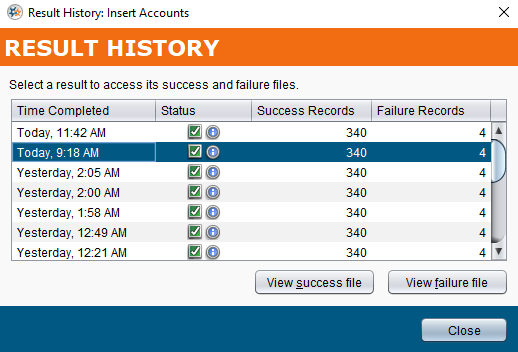
- View Success File: If you are running the operation on a private agent, selecting the View Success File button displays the first 100 records that successfully processed within a popup window.
- View Failure File: If you are running the operation on a private agent, selecting the View Failure File button displays the first 100 records that failed to process within a popup window.
In this example, three records are shown:
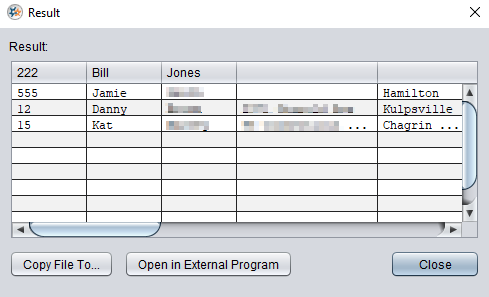
- Copy File To: Saves the success or failure records to a CSV file with the default file name
salesforce.csv. - Open External Program: This option is currently not available.
Note
The success and failure files are available for viewing from the private agent for 14 days by default. The files are automatically deleted from the private agent after 14 days by the Jitterbit File Cleanup Service. The number of days the files are saved can be changed by editing the jitterbit.conf file in the [ResultFiles] section (see Editing the configuration file). You can also change the success and failure file rules by Editing the Jitterbit file cleanup service rules for private agents.